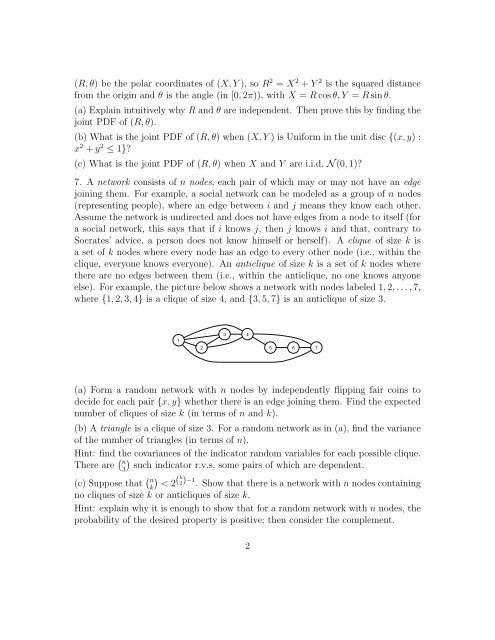Strategic Practice and Homework 8 - Projects at Harvard
Strategic Practice and Homework 8 - Projects at Harvard
Strategic Practice and Homework 8 - Projects at Harvard
You also want an ePaper? Increase the reach of your titles
YUMPU automatically turns print PDFs into web optimized ePapers that Google loves.
(R, ✓) bethepolarcoordin<strong>at</strong>esof(X, Y ), so R 2 = X 2 + Y 2 is the squared distancefrom the origin <strong>and</strong> ✓ is the angle (in [0, 2⇡)), with X = R cos ✓, Y = R sin ✓.(a) Explain intuitively why R <strong>and</strong> ✓ are independent. Then prove this by finding thejoint PDF of (R, ✓).(b) Wh<strong>at</strong> is the joint PDF of (R, ✓) when(X, Y ) is Uniform in the unit disc {(x, y) :x 2 + y 2 apple 1}?(c) Wh<strong>at</strong> is the joint PDF of (R, ✓) whenX <strong>and</strong> Y are i.i.d. N (0, 1)?7. A network consists of n nodes, eachpairofwhichmayormaynothaveanedgejoining them. For example, a social network can be modeled as a group of n nodes(representing people), where an edge between i <strong>and</strong> j means they know each other.Assume the network is undirected <strong>and</strong> does not have edges from a node to itself (forasocialnetwork,thissaysth<strong>at</strong>ifi knows j, thenj knows i <strong>and</strong> th<strong>at</strong>, contrary toSocr<strong>at</strong>es’ advice, a person does not know himself or herself). A clique of size k isasetofk nodes where every node has an edge to every other node (i.e., within theclique, everyone knows everyone). An anticlique of size k is a set of k nodes wherethere are no edges between them (i.e., within the anticlique, no one knows anyoneelse). For example, the picture below shows a network with nodes labeled 1, 2,...,7,where {1, 2, 3, 4} is a clique of size 4, <strong>and</strong> {3, 5, 7} is an anticlique of size 3.12345 67(a) Form a r<strong>and</strong>om network with n nodes by independently flipping fair coins todecide for each pair {x, y} whether there is an edge joining them. Find the expectednumber of cliques of size k (in terms of n <strong>and</strong> k).(b) A triangle is a clique of size 3. For a r<strong>and</strong>om network as in (a), find the varianceof the number of triangles (in terms of n).Hint: find the covariances of the indic<strong>at</strong>or r<strong>and</strong>om variables for each possible clique.There are n 3such indic<strong>at</strong>or r.v.s, some pairs of which are dependent.(c) Suppose th<strong>at</strong> n < 2 (k 2) 1 .Showth<strong>at</strong>thereisanetworkwithn nodes containingkno cliques of size k or anticliques of size k.Hint: explain why it is enough to show th<strong>at</strong> for a r<strong>and</strong>om network with n nodes, theprobability of the desired property is positive; then consider the complement.2
















